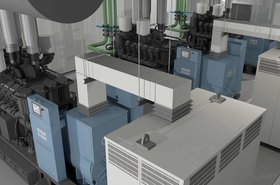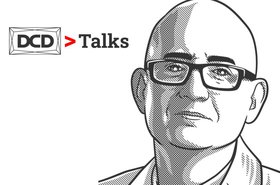Cotton mills and iron foundries were the factories of the Industrial Age, automating and standardizing the manufacture of goods.
Nowadays, it is data centers that have emerged as the factories of the Information Age, automating and standardizing the processing of vast amounts of data into information, entertainment and insight.
As with the early factories, the capital intensity of data centers means that time is money: they must work all day every day, as close to peak capacity as possible, to make the most efficient use of the financial resources tied up in them.
Time is also money when it comes to planning, building and commissioning new data centers, whether they operate at the edge of the network to provide local capacity at low latency, in regional centers to consolidate multiple data streams, or at hyperscale to serve massive data-led organizations such as search companies, online retailers and mobile network operators.
Such infrastructure projects must be carefully specified, meticulously planned, and implemented with great precision. This approach ensures that the right parts arrive on site at the right time in the right order, to minimize the time it takes to build the data center, populate it with the necessary equipment, commission it and put it to work.
Failure to implement the correct plan can cause significant extra costs during the build, and this can open the data center contractor to penalties for over-running the schedule.
Late delivery of a data center will also affect the revenue opportunities of both its operator and their customers. With internet traffic growing around three percent a month, delaying the completion of a data center can leave significant opportunities untapped.
Why modularity in data centers?
One response to the growing demand for data centers and the rising importance of getting them built and commissioned quickly is a shift to modularizing the process.
In this approach, servers, networking equipment and ancillary services such as back-up power generation are all built and tested offsite at supplier factories and then delivered to site for ‘plug and play’ installation.
It has the attractive corollary of enabling data center architects to specify and build the infrastructure for very large data centers, but only populate them with equipment when demand for additional capacity justifies that investment.
For some applications, where the timing of growth in demand is uncertain, data center architects may also create the infrastructure for a large facility but then only populate it with the servers and networking equipment needed to serve current demand.
Extra equipment can then be added as modules, usually in the form of 40-foot containers populated with pre-tested server, networking, power, and security equipment. Genset manufacturers are beginning to offer modular versions of their equipment to match this incremental approach to building data centers.
A modular approach can also streamline the build process, reduce its carbon footprint, and lower costs.
Although it might seem that a shift to modular design would, as in the Industrial Revolution, lead to greater standardization, things are different in the Information Age.
Rather than having to support changes to complex systems like backup generators (gensets) during an onsite integration phase, modular designs can be adjusted and tested to meet customer needs in the equipment maker’s factory.
This gives them the confidence to offer products with multiple standard options, as well as to support further customizations to more closely serve the needs of individual projects.
Direct access to planners, designers, manufacturing expertise, testing equipment, quality-control systems and all the tacit knowledge that is built up in a business, makes support for product changes much easier and more deterministic than if it had to be done onsite.
One-stop-shop data center manufacturing
This kind of modularity requires deep engineering experience and innovative design strategies to make it work.
For generators, it means having own-brand engines, cooling systems and other ancillary equipment and integrating it seamlessly with robust containers or canopies fitted with the latest soundproofing.
This requires significant in-house expertise, with teams of engineers ensuring that designers make the most of the available space within every module.
It also needs one-stop-shop manufacturing capabilities, with generators and their external housings produced in the same location, to ensure repeatable build quality and consistent technical performance.
This one-stop-shop approach can be extended so that the whole process of planning, specifying, building, delivering, commissioning and maintaining a genset is handled by a single supplier.
This makes sense for data center architects, who really only want to know that the solution they specify is right for the job and will work when it is needed. And it makes sense for the supplier, who can take end-to-end responsibility for building, integrating, and testing the equipment in their factories so that they can deliver, commission and maintain it without calling in third parties.
Accelerating time-to-market
Centralizing genset engineering also increases the determinism in the process and reduces the chances of unexpected delays, because one entity has control over it from end to end.
It does away with the need to work with and rely upon the efforts of third-party fabricators, whose service quality may vary.
It increases product quality, because all the parts are being made in a dedicated facility, for a single purpose, under a common quality-control scheme. And it increases product reliability, since it is easier to track any issues, find their root causes and rectify them quickly when all the work is being done in-house, rather than by multiple suppliers who may not want to take responsibility for issues and the costs of mitigating them.
At Kohler, all of these processes are handled within a single manufacturing plant – usually the Kohler headquarters in Brest, France – eliminating the need for third-party fabricators and packagers. This helps ensure consistent build quality for a range of power solutions optimized for data center applications.
With demand for cloud services growing so rapidly, data center architects are looking for efficient, cost-effective ways to build facilities that enable them to match the level of capital investment to current demand, while providing a low-cost way to expand in future. Modular data centers, and modular ancillary equipment such as backup gensets, make this possible.
More from Kohler
-

DCD Awards 2021 shortlist announced!
The 15th annual ceremony will be hosted in London on 8 December & broadcast live worldwide
-

How Kohler thinks big and designs small
Density is increasing in order to keep up with demand
-

Sponsored Kohler brings BIM digitalization to construction
Kohler is bringing digital transformation to the construction industry at large via the BIM Object portal


